

Soft Drinks Stories: Tracing Fanta to Newtown, Wales. With a complex and largely hidden production process, along with the focus on branding and business image, it is easy to overlook the physical resources it takes to actually make a product like Fanta.
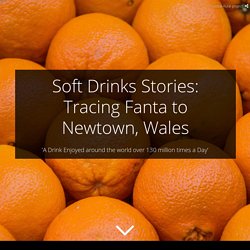
Looking beneath the surface of the ingredients list, even a short way, reveals a tangle of environmental, political and social issues. If we simplify the vast variations we have seen, all orange Fanta contains carbonated water, sweeteners, flavourings and colouring. Water is usually taken from public supplies, subject to much protest in water stressed areas. According to Marion Nestle’s research, water used directly in manufacture of concentrates and end products is between 1.4-2.7 litres per litre of soft drink. If you account for the water needed for all the ingredients and packaging (sugar production takes a lot of water), the water footprint for one litre of soft drink has been estimated at between 340-670 litres, depending on what kind of sweetener is used.
Waste from Bottled Drinks. Characteristics of the rural-urban fringe. Inside Makoko: danger and ingenuity in the world's biggest floating slum. “One bucket, one life,” says Ojo, puffing on a marijuana rollup.
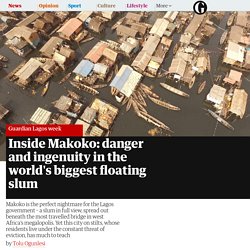
We have stopped by the Floating School, a two-storey solar-powered wooden structure that floats on the Lagos lagoon on a bed of plastic barrels. I ask him to explain what he means. It’s the young fisherman’s way of summing up the dangerous exertion that is his part-time vocation: sand dredging off the coast of Makoko, the world’s biggest floating city.
The dredgers, he explains, descend a wooden ladder into the depths of the lagoon, armed with only a bucket and the will to live. The depths to which they go mean total submersion. BBC - Evan Davis - Mind The Gap: London Vs The Rest 1. How Malawi reduced infant mortality. My husband was executed. Nigeria in Crisis. TNCs in NEEs – Geography Cat finds out more – Geography Cat. TNC stands for transnational corporation, this means a global company that operates in many different countries.
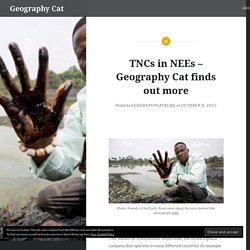
An example of a TNC is Unilever; it has headquarters in the UK and the Netherlands, research and development facilities in both of those nations and in the USA, India and China, and production plants in another thirteen countries, including Brazil, Nigeria and Mexico. Unilever’s wide variety of products are available to buy in 190 countries. NEE stands for newly emerging economy, this term refers to countries that are newly or recently industrialised and whose economy is growing at a fast pace.
Examples of NEEs include Brazil, Mexico, Nigeria, India and China. TNCs are usually attracted to NEEs because of their large workforces, low wages and potential financial incentives. How can industrial growth benefit a low income country or newly emerging economy? Global inequality is on the rise – but at vastly different rates across the w... Inequality is rising almost everywhere across the world – that’s the clear finding of the first ever World Inequality Report.
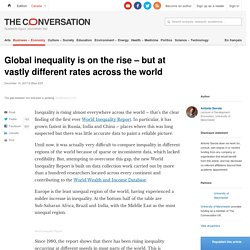
In particular, it has grown fastest in Russia, India and China – places where this was long suspected but there was little accurate data to paint a reliable picture. Until now, it was actually very difficult to compare inequality in different regions of the world because of sparse or inconsistent data, which lacked credibility. But, attempting to overcome this gap, the new World Inequality Report is built on data collection work carried out by more than a hundred researchers located across every continent and contributing to the World Wealth and Income Database.
Europe is the least unequal region of the world, having experienced a milder increase in inequality. Oil spills in Nigeria: The true price of crude oil. 'Absolutely shocking': Niger Delta oil spills linked with infant deaths. Babies in Nigeria are twice as likely to die in the first month of life if their mothers were living near an oil spill before falling pregnant, researchers have found.

A new study, the first to link environmental pollution with newborn and child mortality rates in the Niger Delta, shows that oil spills occurring within 10km of a mother’s place of residence doubled neonatal mortality rates and impaired the health of her surviving children. Crucially, oil spills that occurred while the mother was still pregnant had no effect on child or neonatal mortality. But even spills that happened five years before conception doubled the neonatal mortality rate from 38 deaths to 76 deaths for every 1,000 births, the data found. “The results from the study are absolutely shocking,” said Roland Hodler, an economics professor from the University of St Gallen in Switzerland, who led the study. “I didn’t expect to see this effect on pre-conception. “This is a tragedy. Life expectancy. Highest value export of each nation (4000x2088) : MapPorn. Nigeria's 'champagne' economy bucks Boko Haram effect.
Image copyright Getty Images Nigeria is one of the world's fastest growing markets for champagne and private jets, thanks to a booming economy boosted by the thriving sectors of mobile phones, banking and Nollywood.
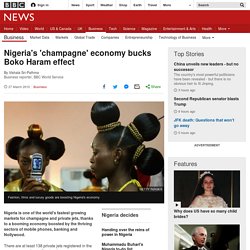
There are at least 138 private jets registered in the country, according to Bombardier. The country became Africa's largest economy in 2014, if the latest overhaul of statistics is to be believed. Changing the base year calculations from 1991 to 2010 certainly seems to have had a flattering effect. Nigeria has also become the region's top destination for foreign direct investment, with inflows now no longer just concentrated on the oil and gas industry.
You draw the chart: How has life changed in 60 years? In October 1957, BBC Radio 4's Today programme went on the air for the first time.

A lot has changed in the last 60 years: we are living much longer; attitudes to sex and marriage have become more relaxed; house prices have risen and the demographics of the UK have changed. But do you know by how much?